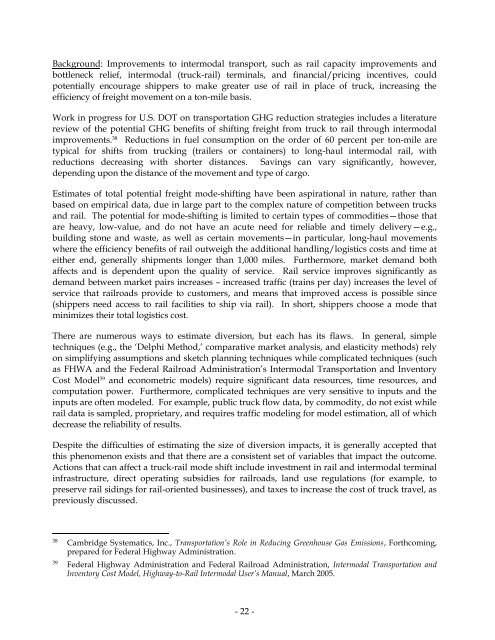Assessment of Fuel Economy Technologies for Medium and Heavy ...
Assessment of Fuel Economy Technologies for Medium and Heavy ...
Assessment of Fuel Economy Technologies for Medium and Heavy ...
You also want an ePaper? Increase the reach of your titles
YUMPU automatically turns print PDFs into web optimized ePapers that Google loves.
Background: Improvements to intermodal transport, such as rail capacity improvements <strong>and</strong><br />
bottleneck relief, intermodal (truck-rail) terminals, <strong>and</strong> financial/pricing incentives, could<br />
potentially encourage shippers to make greater use <strong>of</strong> rail in place <strong>of</strong> truck, increasing the<br />
efficiency <strong>of</strong> freight movement on a ton-mile basis.<br />
Work in progress <strong>for</strong> U.S. DOT on transportation GHG reduction strategies includes a literature<br />
review <strong>of</strong> the potential GHG benefits <strong>of</strong> shifting freight from truck to rail through intermodal<br />
improvements. 38 Reductions in fuel consumption on the order <strong>of</strong> 60 percent per ton-mile are<br />
typical <strong>for</strong> shifts from trucking (trailers or containers) to long-haul intermodal rail, with<br />
reductions decreasing with shorter distances. Savings can vary significantly, however,<br />
depending upon the distance <strong>of</strong> the movement <strong>and</strong> type <strong>of</strong> cargo.<br />
Estimates <strong>of</strong> total potential freight mode-shifting have been aspirational in nature, rather than<br />
based on empirical data, due in large part to the complex nature <strong>of</strong> competition between trucks<br />
<strong>and</strong> rail. The potential <strong>for</strong> mode-shifting is limited to certain types <strong>of</strong> commodities—those that<br />
are heavy, low-value, <strong>and</strong> do not have an acute need <strong>for</strong> reliable <strong>and</strong> timely delivery—e.g.,<br />
building stone <strong>and</strong> waste, as well as certain movements—in particular, long-haul movements<br />
where the efficiency benefits <strong>of</strong> rail outweigh the additional h<strong>and</strong>ling/logistics costs <strong>and</strong> time at<br />
either end, generally shipments longer than 1,000 miles. Furthermore, market dem<strong>and</strong> both<br />
affects <strong>and</strong> is dependent upon the quality <strong>of</strong> service. Rail service improves significantly as<br />
dem<strong>and</strong> between market pairs increases – increased traffic (trains per day) increases the level <strong>of</strong><br />
service that railroads provide to customers, <strong>and</strong> means that improved access is possible since<br />
(shippers need access to rail facilities to ship via rail). In short, shippers choose a mode that<br />
minimizes their total logistics cost.<br />
There are numerous ways to estimate diversion, but each has its flaws. In general, simple<br />
techniques (e.g., the ‗Delphi Method,‘ comparative market analysis, <strong>and</strong> elasticity methods) rely<br />
on simplifying assumptions <strong>and</strong> sketch planning techniques while complicated techniques (such<br />
as FHWA <strong>and</strong> the Federal Railroad Administration‘s Intermodal Transportation <strong>and</strong> Inventory<br />
Cost Model 39 <strong>and</strong> econometric models) require significant data resources, time resources, <strong>and</strong><br />
computation power. Furthermore, complicated techniques are very sensitive to inputs <strong>and</strong> the<br />
inputs are <strong>of</strong>ten modeled. For example, public truck flow data, by commodity, do not exist while<br />
rail data is sampled, proprietary, <strong>and</strong> requires traffic modeling <strong>for</strong> model estimation, all <strong>of</strong> which<br />
decrease the reliability <strong>of</strong> results.<br />
Despite the difficulties <strong>of</strong> estimating the size <strong>of</strong> diversion impacts, it is generally accepted that<br />
this phenomenon exists <strong>and</strong> that there are a consistent set <strong>of</strong> variables that impact the outcome.<br />
Actions that can affect a truck-rail mode shift include investment in rail <strong>and</strong> intermodal terminal<br />
infrastructure, direct operating subsidies <strong>for</strong> railroads, l<strong>and</strong> use regulations (<strong>for</strong> example, to<br />
preserve rail sidings <strong>for</strong> rail-oriented businesses), <strong>and</strong> taxes to increase the cost <strong>of</strong> truck travel, as<br />
previously discussed.<br />
38<br />
Cambridge Systematics, Inc., Transportation’s Role in Reducing Greenhouse Gas Emissions, Forthcoming,<br />
prepared <strong>for</strong> Federal Highway Administration.<br />
39<br />
Federal Highway Administration <strong>and</strong> Federal Railroad Administration, Intermodal Transportation <strong>and</strong><br />
Inventory Cost Model, Highway-to-Rail Intermodal User’s Manual, March 2005.<br />
- 22 -
















